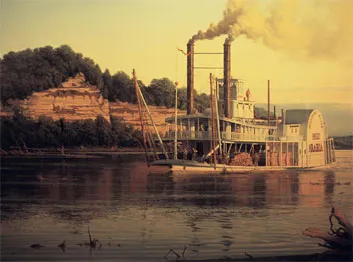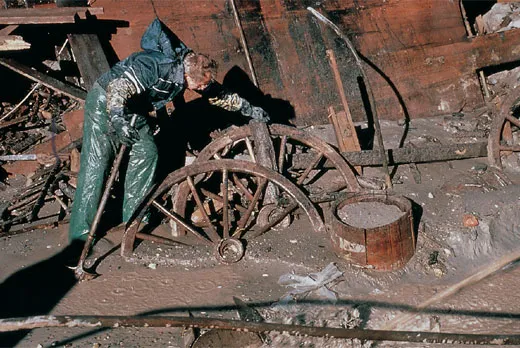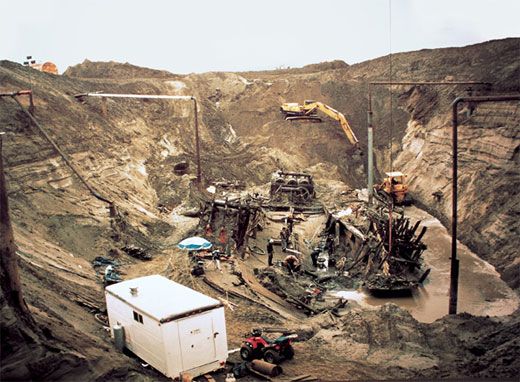Pay Dirt
When self-taught archaeologists dug up an 1850s steamboat, they brought to light a slice of American life
On a steamy July day in 1987, David Hawley walked through rows of ripening Kansas corn, listening to chirps coming from a black box cradled in his hands. Somewhere below the cornfield, Hawley believed, lay the steamboat Arabia, which had struck a submerged tree or snag and, on September 5, 1856, vanished beneath the muddy waters of the Missouri River. As he pushed through the stalks with his magnetometer, which measures the intensity of the magnetic field beneath the earth's surface, Hawley figured he was about in the middle of what once had been the river's channel.
"I didn't know where I was going, and I couldn't see very well through the corn," Hawley, 54, recalls. He had walked the field for the better part of the afternoon when the chirping suddenly accelerated. "I got real excited. It was like a bull's-eye. I knew I was there. I took a few more steps. It kept on jumping. I felt like a kid in a candy store. I said to myself, ‘I've got it! This is one big fish, and we're going to reel you in!'"
Inspired by tales of lost consignments of gold and valuable cargoes of whiskey, Hawley, his father, Bob, and younger brother, Greg, had searched for years for wrecks of sunken Missouri River steamboats, nearly 300 of which have been documented. By 1987, they had little more than old timbers to show for their efforts and, in one disappointing instance, a cargo of waterlogged salt pork. The Hawleys considered themselves treasure hunters who would sell what they found for whatever profit they could make. But the steamboat David Hawley stumbled onto that July afternoon would transform them into archaeologists, and in turn, preservationists, curators and fundraisers for a new museum. It would also enlarge historians' understanding of the American frontier and the era when the paddle wheel was queen of the Western waters.
From their research, the Hawleys knew that Arabia had been launched in 1853 on the Monongahela River in Pennsylvania; newspapers of the time described the boat as a "handsome and staunch packet...furnished throughout with the latest accommodations and improvements for the comforts of the passengers and conveyance of freight." They knew, too, that Arabia carried Mormon settlers on their way to Utah and soldiers to forts in distant Montana. Arabia had even played a role in the battle for "Bleeding Kansas," when pro-slavery men discovered crates of rifles destined for abolitionists in the ship's hold and nearly lynched the passengers who had brought them aboard. The Hawleys had also come across an eyewitness account of Arabia's last moments. "There was a wild scene on board," recalled a survivor named Abel Kirk. "The boat went down till the water came over the deck, and the boat keeled over on one side. The chairs and stools were tumbled about and many of the children nearly fell into the water." Amazingly, considering that Arabia sank in less than ten minutes, all 130 passengers, and the crew, survived.
Bob Hawley, 77, calls his clan "just a run-of-the-mill blue-collar family," one that owned a refrigerator business in Independence, Missouri. Hawley's ancestors went West to join up with the first settlers in Utah. "My great-great-grandfather was told he had to get himself another wife," says Bob, "but he just couldn't make himself do it, so he left Utah in the dead of night." From his father, Gerry, a blacksmith, Bob inherited mechanical ingenuity and a stubborn perfectionism that would serve the Hawleys well in their quest to salvage Arabia.
By the time David had located the vessel, the Hawley men had already formed a partnership with an old friend, Jerry Mackey, who owned several local Hi-Boy restaurants, and with Kansas contractor Dave Luttrell. Having obtained permission to excavate from the farmer who owned the land, they now brought in diesel generators they had bought from a family in Missouri, pipe from Oklahoma and a secondhand crane they floated in by barge. (In 1988 the river was about half a mile from the site.)
The Hawleys began digging in mid-November, working 12- to 14-hour days, seven days a week. On dry days, sand worked its way into their ears, noses and mouths. During wet weather, the Hawleys fought mudslides and floods that surged unpredictably out of the spongy, soggy soil. To remove water from the site faster than it seeped in, Bob designed a system of pumps, each displacing 1,000 gallons per minute. The pumps had to be dismantled to prevent them from freezing at night, then laboriously reassembled the next morning.
Luttrell's bulldozers cut into what had once been the Missouri's channel until they were nearly 30 feet below ground level. On November 30, after 17 days of digging, a power shovel scraped across a piece of wood. It proved to be Arabia's larboard paddle wheel. A few days later, the top of a barrel appeared in the ooze. Jerry Mackey pried off the barrel's lid, and Bob Hawley reached down into mud and pulled out an assortment of cups and dishes—exquisite Wedgwood china. Bob Hawley ran to his car phone and called his wife, Florence. "Come on down here!" he shouted.
"I'm cooking chili," she protested.
"Forget the chili!" Bob bellowed. "We found it!"
Aware that exposure to oxygen would quickly destroy fabric and metal alike, the Hawleys stored the china, clothing, tools and thousands of other objects they removed from Arabia in commercial freezers at Mackey's restaurants. Wooden artifacts, including timbers, needed to be stored in water to prevent them from shrinking and cracking. For this, the Hawleys rented huge tanks. (Preservation experts told them to stabilize metal with tannic acid, and store organic materials in a solution of polyethylene glycol.)
Bob and Florence Hawleys' suburban house soon took on the look of a bizarre 19th-century general store. Boots soaked in Tupperware bowls. Tin coffeepots and cups hung from backyard trees. Millions of beads filled bowls all over the kitchen. Florence sewed coats, shirts and shoes back together, blocked hats and loosened impacted mud from beads. "Every time I walked by one of those bowls of beads, I'd slosh it, until little by little they gradually separated from the mud," she recalls.
"I was taken aback when I saw all these items," Bob Keckeisen, director of the Kansas State Historical Society Museum, in Topeka, told me. "It really challenged our idea of what life was like on the frontier just two years after Kansas became a territory. It's a real surprise that such goods were available. They show us that settling and town building were happening all at once, and that people wanted nice things and some could afford them." The variety of goods also challenge the idea that the West was primarily a ‘safety valve' for people who had run out of options in the East. Adds Keckeisen: "The settlers who were ordering these things were middle-class people, who bought nice goods as soon as they could."
Steamboating on western rivers began in 1811, just four years after Robert Fulton's steam-driven Clermont first chugged up the Hudson River. By the mid-1850s, some 60 steamboats were plying the Missouri alone, from the levees of St. Louis to remote Army posts nearly 2,000 miles away. "The river was the I-70 of its day," says Kathy Borgman, executive director of the Friends of Arrow Rock, a local preservation group in Arrow Rock, Missouri, a former river port between St. Louis and Kansas City. "The whole world came through on the riverboats." Indeed, steamboats were floating microcosms of mid-19th-century America, where traders, gamblers and speculators of every stripe rubbed shoulders with Missouri slave owners, Mormons and mountain men. Free Staters en route to Kansas mingled with Indians on their way home from Washington, D.C., emigrants bound for Oregon or the California gold fields, Yankee businessmen, and bullwhackers who drove the wagon trains that crossed the plains.
Compared with navigating the broad Mississippi, the Missouri was notoriously difficult. The river was a kind of giant dodgem course, "whose alluvial banks," wrote Mark Twain, himself an apprentice pilot in the 1850s, "cave and change constantly, whose snags are always hunting up new quarters, whose sand-bars are never at rest, whose channels are forever dodging and shirking, and whose obstructions must be confronted in all nights and all weathers without the aid of a single lighthouse or a single buoy."
"It is the hungriest river ever created," one observer said. "It is eating all the time—eating yellow clay banks and cornfields, eighty acres at a mouthful; winding up its banquet with a truck garden and picking its teeth with the timbers of a big red barn." During dry spells, when the river shrank to the depth of a pond, steamboat captains had to order a pair of stout timbers, or spars, lowered point-down into the sand at the front of the boat, then driven forward by the paddle wheel. "It was like attempting to walk on stilts, or more like jumping onto stilts," says Robert Mullen, the collections manager at the Missouri Historical Society, in St. Louis. "It would lift the boat a few inches just to advance it a few inches."
But the steamboats were also magical apparitions, floating palaces with glamorous interiors. Images of sunbursts and famous battles embellished paddle-wheel boxes; the tops of smokestacks bore cutout silhouettes of exotic plumes or ferns; colorful pennants snapped on the wheelhouse. When a boat neared shore, a calliope struck up a polka or the Virginia reel, its strains floating across the water like a promise of deliverance. Staterooms finished in mahogany were appointed with silk draperies and rich carpets. Entering the saloon of a riverboat, wrote Twain, was "like gazing through a splendid tunnel" which "glittered with no end of prism-fringed chandeliers." The cuisine was equally impressive, although the menu for a typical buffet in 1852 may appeal rather less to the modern palate: beef, veal, pork, liver sauce, venison, boiled tongue, plus "side dishes" of mutton, pork ragout, beef heart and "calf head à la mode."
Steamboats could be hugely profitable; a paddle wheeler that cost about $15,000 to build could earn as much as $80,000 in a single journey. But their lives tended to be short; a Missouri steamboat rarely lasted more than three years. Boats caught fire, blew up and sank routinely. Between 1830 and 1840 alone, an estimated 1,000 lives were lost on Western rivers.
By far the greatest danger, however, was posed by snags, which accounted for almost two out of three of the steamboats lost on the Missouri. Twain describes the scene: "The whole vast face of the stream was black with drifting dead logs, broken boughs, and great trees that had caved in and been washed away. It required the nicest steering to pick one's way through this rushing raft, even in the daytime, when crossing from point to point; and at night the difficulty was mightily increased; every now and then a huge log, lying deep in the water, would suddenly appear right under our bows, coming head-on; no use to try to avoid it then; we could only stop the engines, and one wheel would walk over that log from one end to the other, keeping up a thundering racket and careening the boat in a way that was very uncomfortable to passengers. Now and then we would hit one of these sunken logs a rattling bang, dead in the center, with a full head of steam, and it would stun the boat as if she had hit a continent."
The river nearly claimed the Hawleys as well. One morning during excavation of Arabia, Bob and Greg were working knee-deep in mud when a sudden rush of groundwater overtook them. Struggling to free themselves from the glutinous muck, they were trapped in the rising waters. Only a providential occurrence prevented tragedy: collapsing sand sealed the fissure that had opened. Bob managed to escape just as the water reached his chest. "A short man would have died down there," Greg joked afterward.
On January 24, 1989, the Hawleys uncovered a jagged stump still lodged below Arabia's waterline—obviously the instrument of her demise. Today that otherwise nondescript snag is but one of hundreds of thousands of salvaged items on display in the Arabia Steamboat Museum, which opened on November 13, 1991, near the landing in Kansas City, Missouri, from which the vessel departed in 1856. The artifacts themselves converted the Hawleys from treasure hunters into historians. "We fell in love with the story of the Arabia," says 49-year-old Greg Hawley. "When we first broke ground, we didn't realize that it would turn out to be the greatest treasure of all." Soon, he says, "We realized that we had a national treasure on our hands. Starting a museum was the only logical step." The museum, whose state-of-the-art preservation laboratory processes some 700 objects from Arabia each year, attracts some 200,000 visitors annually. "It would have been easy for the Hawleys to break up that collection, but they didn't," says the Kansas State Historical Society's Bob Keckeisen. "They must be commended for seeing the greater significance in this collection."
Steamboats plying their trade are long gone from the waters of the Missouri. The Civil War, the collapse of the plantation economy and the coming of the cross-continental railroad spelled the end of river trade. A handful of steamboats continued to operate into the 20th century (and a few today have survived as tourist vessels), but the glory years would never return. Once-bustling landings have been overtaken by tangled thickets and woodland. Even the river itself has been tamed—by levees, dredging and channel reconfigurations that have stranded some former ports far inland. Yet the great, gray-green river still flows, smooth and wide beneath the wooded bluffs. And sometimes on a summer afternoon, it is still possible to see boys squatting amid the driftwood, old-fashioned fishing rods in hand, like a detail from a painting by George Caleb Bingham—a tantalizing glimpse of a time when Americans were filled with unbridled curiosity about the new continent, and a great white floating palace might at any moment come steaming around the next bend.
Writer Fergus M. Bordewich is the author of Bound for Canaan, a history of the underground railroad published last year.


